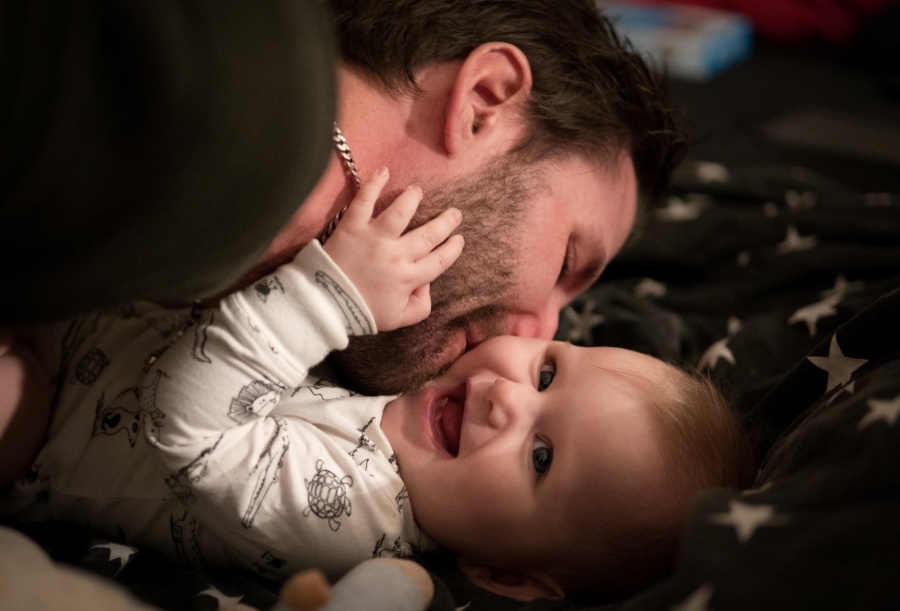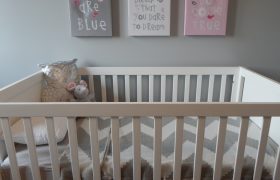Our Guide to Safe Co-Sleeping

Many parents are probably wondering if it is safe to be co-sleeping with their newborns. Almost every mother who is breastfeeding or bottle-feeding has fallen asleep with her baby in her arms. Sometimes it’s the only way they get any rest when they are breastfeeding.
If you are a bedside co-sleeper, there are probably many times you wake up and are alarmed because your infant is snuggled in your armpit. The first thing you check is to see if they are still breathing.
About 99 percent of the time they are still breathing and sleeping deeply, so you tiptoe to their crib and try to put them in their bed. Sometimes, they sleep for a while and other times, they wake up and want to be back in your arms.
The best way to co-sleep with a newborn is to make sure you are sitting up and your arm is propped up safely while you nurse in case you both snooze off. Make sure their nose is free of any breast tissue and hold them firmly, but not tightly to your breast.
There are some toddlers that have a problem when it’s time to transition out of their parent’s bed into their own bed. They end up waking up and crying or crawl out of their toddler beds only to come sleep with their parents and both of you relent. This can be a bad habit if it continues for too long but there are also safe ways to co-sleep with toddlers.
You can either make sure your bed is a king-size so your child doesn’t have an accident and get smothered, or place a small toddler bed in your room so they know that you are still there and they are not that far away from their parents. Co-sleeping can be frustrating to some parents, but there is a safe guide for co-sleeping available for parents to read.
What Exactly does Co-Sleeping Mean?
Co-sleeping is a term used that means that parents are sleeping near their children and it could be in the same bed or the same room. There are a variety of co-sleeping ways that families try. One is sharing the same bed with the child and the parents co-sleeping with their newborn.
Some families try something called the side-car. Parents will place the side of the crib next to the mother, with one side of the crib down and firmly attached. The other three sides of the crib are still up and secure for the baby. In some cases, the side that is next to mom is removed or just lowered down. This way it’s easier for both mother and her newborn to co-sleep and reach each other easier. You can buy these types of side cribs.

Some families decide to keep whatever they choose like a cradle, bassinet or crib very closely to the parents. This way it’s easy to reach their baby in seconds. If parents are co-sleeping with toddlers in the same room, some make a pallet of sorts that their toddler can co-sleep on within arms reach or they place a toddler bed close by and even at the foot of the bed.
Newborns and toddlers that are co-sleepers may have been used to their own beds at one point in their lives but eventually should be encouraged to come into their parent’s room if something is frightening them or they are sick. Some parents enjoy the convenience of taking care of their children in their room, while others become frustrated about the co-sleeping arrangement.
Advantages
Co-sleeping doesn’t always work for every family but there are still some good advantages to co-sleeping with newborns and toddlers. Parents sleep more and so do their children. The baby is close enough to mom to nurse and fall right back asleep as long as they don’t need a diaper change.
It’s much easier to breastfeed while co-sleeping with your newborn. Your milk supply keeps recirculating when you breastfeed more often. The SIDS factor is reduced when your child is co-sleeping with their parents.
Toddlers and newborns don’t suffer from any anxiety during the night from being separated if they are co-sleeping with their parents. The best thing besides the morning sunshine is a smiling baby or toddler in the morning.

Make the Area Safe for Co-sleeping
If you as parents decide to co-sleep with newborns or toddlers, here are some tips on making the area safe for them to co-sleep. Always put a newborn baby on their back, on a surface that is firm. Never place a newborn on a waterbed or other surfaces that are soft.
Make sure the bedding is the correct size to fit the mattress you are using. Never place any pillows, toys or blankets anywhere near your baby’s face for newborn co-sleeping. Make sure the bed is tight against the wall so your child can’t roll between their bed and get caught between the wall and their bed. Never place your newborn on any surfaces with a space like a couch for instance, because newborns can easily become caught between the cushions.
Guidelines for Safe Co-sleeping
If your family decides to be bedside co-sleepers, make sure that you create a safe area for co-sleeping with newborns and toddlers. Co-sleeping is more common with moms that are breastfeeding because the baby is within easy reach and the family sleeps better. The main concern about co-sleeping is the safety factors.
There are many who view co-sleeping as an unsafe practice for moms and newborns, whether the newborns share the bed or are next to the bed. There are still ways to co-sleep that are safe if parents research all the right guidelines and follow the safety practices of co-sleeping.

Be careful if your newborn is born with low birth weight or is premature. This can be more risky but still beneficial for the newborn to grow faster when co-sleeping. Stay away from all substances when co-sleeping because this is a great risk and could cause accident parents never want to experience.
Newborns are much safer sleeping near their mothers that breastfeed. Never put a baby in bed with older siblings. In addition, don’t swaddle a newborn when co-sleeping because they could overheat or their face could become smothered, increasing the risk of SIDS. Tie up your hair if it’s very long so baby doesn’t get your hair wrapped around their necks causing strangulation.
If one of the parents is considered obese make sure the baby is on a separate bed next to their mother for safety reasons. In addition, if you or your spouse sleep deeply or are very tired, make sure your baby is kept in a separate bed next to you for safety reasons.
Co-sleeping is still very controversial but room sharing is recommended as a second idea for the safety of the newborn, toddler and the family. The main reason is SIDS is still very prevalent in our society and the goal is to keep lowering the percentage of SIDS.






